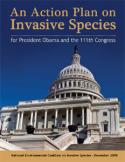
Research Reports
ELI publishes Research Reports available for free download that present the analysis and conclusions of the policy studies ELI undertakes to improve environmental law and policy. These reports contribute to education of the profession and disseminate diverse points of view and opinions to stimulate a robust and creative exchange of ideas. Those publications, which express opinions of the authors and not necessarily those of the Institute, its Board of Directors, or funding organizations, exemplify ELI’s commitment to dialogue with all sectors.
December 2008
In An Action Plan on Invasive Species, the Environmental Law Institute and its partners in the National Environmental Coalition on Invasive Species have identified priority actions for both the Obama administration and the 111th Congress related to invasive species prevention and management. By taking these simple steps, the federal government can make substantial progress toward addressing animal and plant invasive species threats.
Read More >
December 2008
December 2008

December 2008
